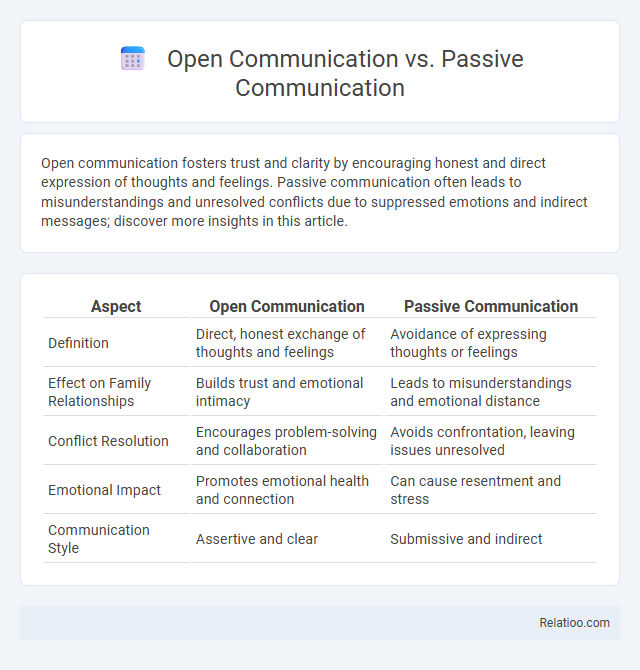Open communication fosters trust and clarity by encouraging honest and direct expression of thoughts and feelings. Passive communication often leads to misunderstandings and unresolved conflicts due to suppressed emotions and indirect messages; discover more insights in this article.
Table of Comparison
| Aspect | Open Communication | Passive Communication |
|---|---|---|
| Definition | Direct, honest exchange of thoughts and feelings | Avoidance of expressing thoughts or feelings |
| Effect on Family Relationships | Builds trust and emotional intimacy | Leads to misunderstandings and emotional distance |
| Conflict Resolution | Encourages problem-solving and collaboration | Avoids confrontation, leaving issues unresolved |
| Emotional Impact | Promotes emotional health and connection | Can cause resentment and stress |
| Communication Style | Assertive and clear | Submissive and indirect |
Understanding Open Communication
Open communication fosters transparency and active engagement, allowing you to express thoughts clearly while encouraging feedback and collaboration. It contrasts with passive communication, where messages are indirect or withheld, often leading to misunderstandings or unresolved issues. Emphasizing open communication in your interactions promotes trust, clarity, and more effective relationships in both personal and professional settings.
Defining Passive Communication
Passive communication is characterized by the avoidance of expressing personal opinions or feelings, often leading to misunderstandings and resentment. Unlike open communication, where individuals assertively share thoughts and emotions to foster clarity and trust, passive communicators typically prioritize others' needs over their own, resulting in unmet expectations. Understanding the distinctions between passive and open communication is crucial for improving interpersonal relationships and enhancing effective dialogue.
Key Differences Between Open and Passive Communication
Open communication encourages transparent and honest dialogue, promoting mutual understanding and active participation, while passive communication often involves withholding opinions or feelings to avoid conflict, leading to misunderstandings and unresolved issues. Your ability to express thoughts clearly and assertively in open communication fosters trust and effective collaboration, whereas passive communication may result in frustration and a lack of clarity. The key difference lies in openness and assertiveness, with open communication prioritizing directness and engagement, and passive communication characterized by silence and avoidance.
Benefits of Open Communication
Open communication fosters transparency, trust, and collaboration within teams, leading to enhanced problem-solving and increased employee engagement. Unlike passive communication, which often results in misunderstandings and unresolved conflicts, open communication encourages honest feedback and active participation. Organizations that prioritize open communication experience improved productivity and stronger interpersonal relationships among team members.
Drawbacks of Passive Communication
Passive communication often results in unmet needs and unresolved conflicts, leading to frustration and decreased self-esteem. Your inability to express thoughts or emotions clearly can cause misunderstandings and negatively impact relationships both personally and professionally. This communication style undermines effective problem-solving and can contribute to long-term dissatisfaction.
Impact on Relationships
Open communication fosters trust and clarity, allowing your relationships to thrive through honest and transparent exchanges. Passive communication often leads to misunderstandings and unresolved conflicts, weakening emotional connections and mutual respect. Contrastingly, aggressive communication can damage relationships by creating defensiveness and resentment, highlighting the importance of balanced openness for healthy interactions.
Effects on Workplace Dynamics
Open communication fosters transparency, collaboration, and trust, leading to enhanced teamwork and increased productivity in workplace dynamics. Passive communication often results in misunderstandings, unresolved conflicts, and decreased morale, hindering effective team interaction and decision-making processes. Contrastingly, assertive communication balances openness with respect, promoting a positive work environment where feedback is exchanged constructively and employee engagement thrives.
Conflict Resolution: Open vs Passive Approaches
Open communication fosters effective conflict resolution by encouraging transparent dialogue and active listening, allowing parties to express concerns and collaboratively find solutions. Passive communication often hinders conflict resolution as individuals avoid expressing their true feelings, leading to misunderstandings and unresolved tensions. In conflict resolution, open communication promotes trust and clarity, while passive communication may exacerbate conflicts due to suppressed emotions and lack of direct engagement.
Strategies to Cultivate Open Communication
Strategies to cultivate open communication include fostering a safe environment where individuals feel comfortable expressing their thoughts and emotions without fear of judgment or retaliation. Encouraging active listening and providing constructive feedback enhances mutual understanding and trust among team members. Implementing regular check-ins and transparent dialogue channels promotes clarity and reduces misunderstandings compared to passive communication, which often leads to unresolved conflicts and diminished collaboration.
Overcoming Passive Communication Habits
Overcoming passive communication habits requires recognizing the limitations of indirect expression and embracing assertiveness to convey your thoughts clearly. By shifting from passive to open communication, you can enhance mutual understanding, build trust, and prevent misunderstandings in personal and professional relationships. Your ability to articulate needs confidently fosters collaboration and strengthens connections, transforming interactions into opportunities for growth.

Infographic: Open Communication vs Passive Communication
 relatioo.com
relatioo.com